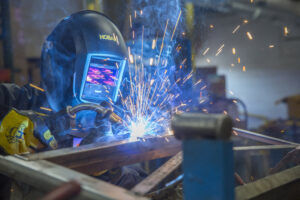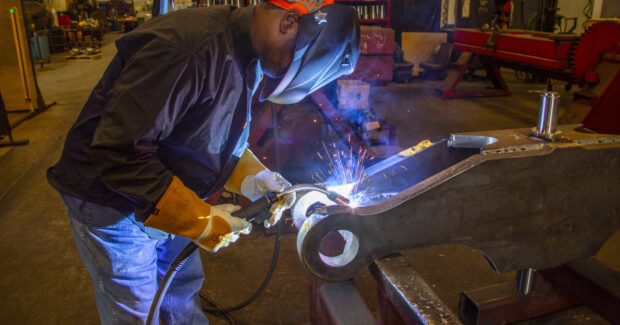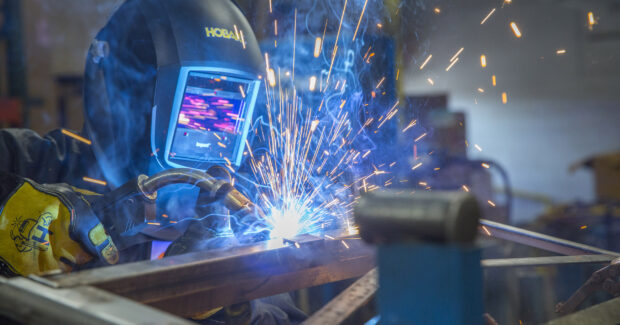Improving Efficiency in the Welding Operation
Making the right choices when selecting filler metal, shielding gas, wire packaging and incoming material boosts throughput.
Posted: August 18, 2023

Many factors can impact efficiency in your welding operation, from the choice of filler metals and shielding gas to the facility layout and workflow. Understanding the available consumable options and following best practices can deliver significant productivity benefits.
If you’re looking to improve efficiency in your welding operation, attention to the following issues can help save time and boost production.
Impact of Filler Metal on Efficiency
The most common filler metals for MIG welding in shop fabrication and manufacturing are solid wire, gas-shielded flux-cored wire and metal-cored wire. Each filler metal has benefits and drawbacks depending on the application.
A purchasing department may look strictly at price when choosing filler metal, but considering different wire options can help solve production challenges. One of the biggest factors that affect efficiency is how much time must be spent on pre-weld and post-weld activities like cleaning the base material or grinding spatter. Some wires require more time spent on these activities, and reducing or eliminating these non-value-added activities can result in substantial time savings.
- Solid wire typically has a lower purchase price, but it’s not the right choice for every application. It provides deep and narrow penetration and works well for welding very clean or blasted base material. Because of its narrow penetration and concentrated arc force, solid wire typically isn’t a good choice for welding very thin metals while in a spray transfer. When welding thin materials in a short circuit or globular transfer, you may see larger spatter that can adhere to the parts and require post-weld cleaning, depending upon the gas type and settings.
- Metal-cored wire is a good choice for in-position welding with higher travel speeds on materials that have mill scale on them. Metal-cored wire typically provides slightly higher deposition rates than solid wire due to increased wire stickout, allowing for similar amperage with higher wire feed speeds. It can help reduce burn-through on thin metals because of the broader, wide penetration profile. Typically, when metal-cored wires produce spatter, it is finer and solidifies in the air; often it won’t adhere to the part, which means less cleanup after welding. In addition, some metal-cored wires are formulated to bring silicon islands to the center of the weld, making it easier to remove them than when using solid wire.
- Gas-shielded flux-cored wire is great for very large weldments that have a mix of in-position and out-of-position welds. Welding out of position with a solid wire typically provides travel speeds of 3”-to-4” per minute, compared to travel speeds of 8”-to-10” per minute with gas-shielded flux-cored wire. The welding skill required to make acceptable welds out of position with gas-shielded flux-cored wire is considerably less than with solid wire, as well. However, keep in mind that flux-cored wire produces a slag that always requires post-weld cleaning and weld cell cleanup — adding time to the process.
Solid wire is a common choice, but in many applications metal-cored and flux-cored wire can deliver significant improvements.
Other Factors That can Improve Efficiency
In addition to selecting the proper filler metal for your application and goals, there are several other factors that play a role in increasing efficiency and reducing downtime.
Shielding Gas Selection
The gas mixture you use affects the level of spatter created during welding, which in turn increases or decreases the time spent on post-weld cleanup. A 75% argon/25% carbon dioxide gas typically produces more spatter when using a solid wire or a metal-cored wire than a 90/10 gas mix does. The general rule of thumb is that using shielding gas with a higher argon content results in less cleanup time because it provides a more stable arc and less spatter. In addition, a 90/10 gas mixture typically provides cleaner weld deposits with fewer silicon islands than a 75/25 gas mixture does, but the base metal condition also contributes to this.
When using gas-shielded flux-cored wire, a 75/25 mixture or 100% carbon dioxide are common choices. Both of these combinations can provide relatively low spatter levels.
Filler Metal Packaging
The size of your welding operation is the main thing that dictates proper filler metal packaging size. Often, significant efficiency benefits can be found with a packaging switch, especially for larger operations. If operators are going through a wire spool every shift, they will spend a lot of time walking back and forth to the storage area to get a new spool and change it out. Switching to a larger package size can reduce downtime for changeovers. Some applications may use welding suitcase feeders, and larger wire spools could fatigue the operators if they must move with the suitcase into small compartments or tight areas.
Some common filler metal packaging sizes for wires are 33-pound, 44-pound and 50-pound spools. There are also 60-pound coil options and, beyond that, larger drum sizes. The larger the spool or drum, the less frequent changeover that is required. However, it’s important to consider storage space and accessibility to the welding cell and wire feeder. If the space isn’t easily accessible, it may be difficult to get a filler metal drum into that area for changeover, adding time to the process.
Choosing the right package size for the application is a way to optimize efficiency, but larger packages are not always better. Keep in mind that wire drums or spools that are too large can be cumbersome and hard to store, which can be problematic for smaller facilities. Also, be aware that having too large of a package that isn’t consumed fast enough may allow time for the product to rust or oxidize, which can cause feeding and weldability issues.
Workflow and Layout
When you want to improve efficiency, you should also look beyond the weld cell. Consider the entire workflow; start where material is brought into the facility and follow it through the process. All incoming materials should be in one spot, with all finished materials at the other end. In between, there should be a logical layout and workflow that doesn’t add unnecessary time to the process. If a small manufacturing facility receives raw material at one point but then must move it to the other end for blasting and prep, this wastes time for every piece produced. Reducing the amount of material movement, when possible, can help improve efficiency in the operation.
Also, consider the base material coming into the weld cell. Is it clean or dirty? Buying material that has not been blasted or cleaned may save money in purchasing, but it adds time and costs in the form of labor for pre-weld cleaning. And when rusty or dirty material is welded with solid wire, operators must use grinding wheels or sanding discs to remove that coating to improve results. Any time spent prepping the material is time that’s not spent welding.
While it’s hard to avoid material cleaning completely, investing in cleaner material at the start of the process can save operator time and improve productivity in the entire operation. Another option is to switch to metal-cored wire, which delivers better results for welding over mill scale.
Gaining Efficiency
Think about your efficiency goals and the requirements of your welding operation when selecting filler metal, shielding gas, wire packaging and incoming material. Making the right choices can help save time and boost throughput.
Subscribe to learn the latest in manufacturing.






